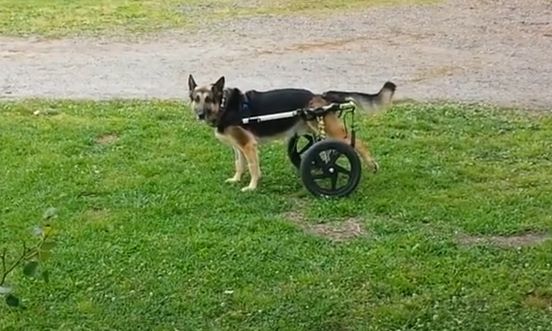Nearly a decade ago, readers of Dog Wheelchair LIFE helped with a special event that very few people know about. It was the day when hundreds of animal lovers saved a bomb-sniffing dog named Igi.
I was reminded of the big day while I was updating the DWL YouTube channel. There, at the very bottom of the page are two videos about Igi’s life after he retired from the Department of Homeland Security. They show Igi as a normal pup who had a family, dog siblings and who loved to run in his wheelchair.
But, before I get too far ahead of myself, I want to share Igi’s whole story.

Igi’s work as a TSA bomb-sniffing dog
Igi was a smart and handsome bomb-sniffing German Shepherd who worked at O’Hare International Airport in Chicago. Every day he accompanied Jim, his partner and handler, as they kept millions of passengers safe.
They patrolled terminals and baggage areas and Igi used his keen sense of smell to detect explosives and other threats. The bond between Igi and Jim was solid and strengthened by years of training and hard work.
Then one fateful day, Igi’s career—and life—took a tragic turn. He ruptured four discs in his spine while playing at home. It left his hind legs paralyzed.

eBook
Find The Right Dog Wheelchair For Your Pet
Your dog has a mobility problem, and you want to buy a wheelchair. But do you know what kind of cart will work best for your dog’s individual needs? After a decade of teaching pet owners how to make the right choice, I put the information into an eBook!
The life of a working dog
Bomb-sniffing dogs like Igi are part of the Transportation Security Administration’s (TSA) Explosives Detection Canine Program. These highly trained dogs work at airports, borders, and major events to sniff out the smallest traces of explosives. Training starts when the dogs are young puppies and often breeds such as Labrador Retrievers, German Shepherds, and Belgian Malinois are used. These dog breeds are known for their intelligence and work ethic.
Dogs are trained to detect specific scents associated with explosives and must learn to remain calm and focused in environment. Their duties include inspecting cargo, luggage, and sometimes entire terminals. These dogs are often paired with a single handler, fostering a deep bond which is important for good teamwork.
Handlers like Jim work long hours—typically 10–12-hour shifts—ensuring their canine partners are cared for, trained, and ready for duty. However, when a bomb-sniffing dog becomes ill, injured, or too old to continue working, retirement is the next step. Rules for retired service dogs vary depending on the agency, but priority is usually given to the handler for adoption.
Igi’s accident and retirement
When Igi suffered his injury, it became clear that he could no longer continue his duties. Jim made the difficult decision to retire the dog. Unfortunately, his demanding job meant he couldn’t provide the round-the-clock care Igi now needed.
And, in addition, Jim was expecting a new canine partner to arrive at his home soon for training. This situation posed another problem because Jim might be expected, at that time, to return Igi to TSA and not have any input about his fate.
All of this left Jim heartbroken but determined to find the best possible home for his beloved partner.

A lifeline through Dog Wheelchair LIFE
Desperate for help, Jim stumbled upon the Dog Wheelchair LIFE blog, which focuses on supporting owners of disabled pets. He reached out explaining Igi’s story and his dilemma. That’s when I decided to take action.
It was a Saturday, and I wasn’t sure if the weekend would slow things down. But I sent a plea for help to our readers, asking if anyone could provide a loving home for Igi. At first, a trickle of emails came in. But as the hours passed, the response snowballed into a flood of messages from all over the country.
In the end there were hundreds of offers to give Igi a new home.
Some readers offered to adopt Igi outright, while others suggested rescue groups specializing in disabled animals. The overwhelming generosity showed the power of community and the good heartedness of people willing to help a dog they had never met.
Finding Igi’s forever home
Together, Jim and I sifted through the offers, narrowing down the list to families who seemed like a good fit. The decision was incredibly tough, but in the end, Igi was placed with a family that seemed tailor-made for him.
The family included children, other dogs, and a husband who worked as a military dog trainer. Their experience and understanding of dogs, combined with their love for animals, made them the perfect choice.
Jim packed up Igi’s gear—his favorite toys, bed, and a new wheelchair—and drove through several states for the dog to meet his potential new family.
The goodbye was difficult, but Jim knew he was making the right choice.

Get the Essential Guide
The Essential Guide of Products for Handicapped Dogs e-book is a labor of love for me. I wrote it to answer your most pressing questions about where to find the best products for your wheelchair dog. You’ll find products you didn’t know existed and each will improve your dog’s quality of life. Print a copy and keep it by your side.
Adjusting to a new life
It took a while for Igi to adapt to his new environment, but slowly he joined the other dogs in playtime, learned to navigate his new home and follow his new mother’s rules. The children adored him, and the family’s experience with dog training ensured Igi received the care and stimulation he needed.
In return, Igi’s new family enjoyed finding out how smart their new pup was, when they introduced him to something new. They were also very surprised to see Igi’s stubborn streak when he didn’t like an activity. Over time, Igi settled well into the family’s routine.
For the first time in his life, Igi experienced what it meant to be a family pet.
Understanding ruptured discs in dogs
Igi’s condition is a reminder of how important it is to recognize and address spinal injuries in dogs. Ruptured discs often manifest as sudden pain, difficulty walking, or paralysis. Common treatments include anti-inflammatory medications, surgery, and physical therapy. For dogs who lose mobility, tools like dog wheelchairs can provide a new lease on life, allowing them to stay active and happy.
A heartwarming ending
Igi’s journey from a bomb-sniffing hero to a cherished family member is a testament to resilience, love, and the power of community. It’s also a reminder of the critical role dogs play in keeping us safe—and the responsibility we have to care for them when their service comes to an end.
When I last talked with Jim, he was continuing his work with a new canine partner, but Igi’s memory will always hold a special place in his heart. For Igi, retirement turned out to be a joyful new chapter, one where he could enjoy the simple pleasures of being a dog.
The readers of Dog Wheelchair LIFE proved; even small acts of kindness can create big changes. Igi’s story is not just one of survival but of thriving, thanks to his dedicated handler, the compassion of strangers, and the love of his new family.
Note: Some of the names in this story have been changed.





Leave a Reply